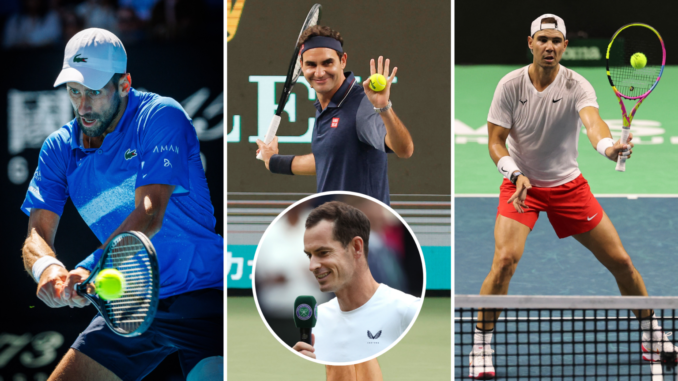
The question hangs in the air, a tantalizing “what if” scenario that has captivated tennis fans and pundits alike: if Andy Murray, a legend in his own right, could step into the role of coach, which of the other titans of the game – Roger Federer, Rafael Nadal, or Novak Djokovic – would he most like to guide? The query, posed in a recent interview, has sparked a wave of speculation and discussion, offering a fascinating glimpse into Murray’s analytical mind and his deep understanding of the nuances of the sport. His response, while perhaps surprising to some, reveals not only his respect for his fellow competitors but also his keen insights into their individual strengths and potential areas for development.
The tennis world has been blessed with an era of unprecedented talent, featuring the “Big Four” – Federer, Nadal, Djokovic, and Murray – who have dominated the sport for over two decades. Each player has carved their own unique path to greatness, showcasing distinct styles and unwavering determination. While their on-court battles have been legendary, the camaraderie and mutual respect between these athletes have also been a hallmark of their era. It is within this context of shared history and deep understanding that Murray considered the hypothetical question of coaching one of his rivals.
The choice is not an easy one. Each of the three players – Federer, Nadal, and Djokovic – possesses a wealth of talent and experience. They have achieved nearly every conceivable accolade in the sport, and their dedication to their craft is beyond reproach. Coaching any of them would be a privilege, an opportunity to work with some of the most gifted athletes in the world.
Murray’s ultimate decision, however, reveals his strategic thinking and his belief in the potential for further growth, even for players at the pinnacle of their careers. He chose, not to reveal his pick publicly, but his reasoning provides valuable insights. He spoke about the specific challenges and rewards associated with coaching each of the three players. He acknowledged their existing strengths but also hinted at areas where he believes he could make a difference.
In considering Federer, Murray spoke about the aesthetic beauty of his game, his effortless grace and artistry on the court. He recognized the challenge of coaching a player whose style is so inherently natural and fluid. The task, he suggested, would be less about making major technical changes and more about fine-tuning existing skills and providing strategic guidance.
When discussing Nadal, Murray emphasized his unparalleled mental fortitude and his relentless intensity. He acknowledged the difficulty of adding anything significant to Nadal’s already formidable mental game. The coaching focus, he implied, would likely revolve around optimizing his physical preparation and ensuring that his body could withstand the rigors of his demanding style of play.
Finally, in considering Djokovic, Murray highlighted his incredible athleticism and his all-around game. He recognized the challenge of coaching a player who is already so complete and versatile. The coaching approach, he suggested, would likely involve subtle adjustments and strategic refinements, helping Djokovic to maintain his edge in an increasingly competitive landscape.
Murray’s reflections on the hypothetical coaching scenario offer a fascinating glimpse into his understanding of the game and his appreciation for the unique qualities of each player. His comments reveal not only his respect for his rivals but also his belief that even the greatest players can continue to learn and improve. It underscores the continuous evolution of professional tennis, where even the smallest adjustments can make a significant difference.
The question of who Murray would most like to coach remains a topic of speculation and debate. Regardless of his ultimate choice, his insights into the strengths and potential areas for development of Federer, Nadal, and Djokovic provide a valuable perspective on the art of coaching and the complexities of elite-level tennis. It’s a reminder that even at the highest levels of the sport, there is always room for growth, adaptation, and refinement. And it is the pursuit of these incremental improvements that often separates the good from the great, and the great from the legendary. Murray’s hypothetical coaching scenario, while a thought experiment, offers a compelling window into the minds of these exceptional athletes and the intricate dynamics of their sport.
Leave a Reply